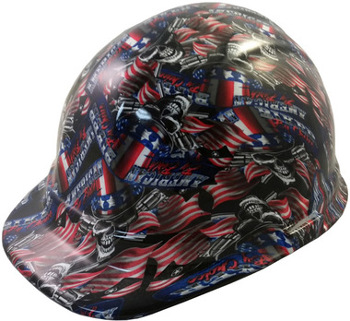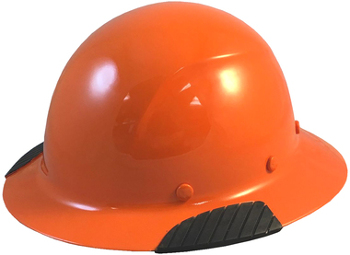Top 5 Things You May Not Know About Hard Hat Safety
Oct 11th 2018
You might think that hard hats have been around for a really long time but in the grand scheme of things they have only been around (in the way we recognize them) for about the last 100 years. Some of the first times that hard hats saw use were during the building of the Hoover Dam in 1931 and the building of the Golden Gate Bridge in 1933. Soon after these projects were completed, you could see hard hats at many different work sites.
We even have a specific organization called the Occupational Safety and Health Administration (OSHA) that requires that people wear hard hats if they are going to be working in an area that has the risk of head injury, if they are around falling or flying objects, or if they are at risk of electrical shocks or burns. This mandate came about in 2012 directly from OSHA. Now hard hats are one of the most common pieces of personal protective equipment (PPE) around. OSHA has been mandating head protection since 1974.
The Makeup of a Hard Hat
There are actually five different parts to most hard hats. Most people only think of the shell and the suspension when it comes to a hard hat but there is also a possible insulator, a brim, and extra PPE equipment that can be added to your hard hat to offer additional protection.

One of the most basic parts of your hard hat is the outer shell. This part allows your hat to help deflect blows to your head. This is a great feature to have if you are working in an area that has falling debris. It is also the simplest concept to understand in a hard hat.
The second part of the hard hat is the suspensionM, which is another feature that people will commonly think of when they think about a hard hat. This is more or less a shock absorber for your head. This gives you space between the head and the hard hat so that an impact can be cushioned.
Those of you who are working in or near anything electrical should have an insulator in your hard hat. This insulator will protect you against any electrical shocks that may occur throughout the course of your day. You will still have to make sure you have a properly rated hard hat before you begin work for the day.
The fourth feature of the hard hat is one that most people don’t really think about, the brim. The brim offers you protection from spills or liquids that might run into your eyes. It can also keep any splashes or spills from touching the scalp as well. It is a good idea to keep your hat forward facing as, obviously, if it is backwards the brim will be useless to you.
The final feature of a hard hat is the different accessories that can be added to it to help ensure your safety even more. You can actually get a face shield to add to your hard hat that will protect your face and will mount directly onto your hard hat instead of having to put it on your head. This is so you don’t have to sacrifice the protection offered by the hard hat by putting the face shield under the hat.
Types of Hard Hats
You will need to make sure that whatever job you are doing, you are using the correct hard hat to get the job done safely. There are different types and classes of hard hat and you should be familiar with them in order to determine which hat you need.
- Type I – protects from impacts directly above worker
- Type II – protects the worker from blows to head from the side, front or back
- Class E (Electrical) – protects the worker against 20,000 volts of electricity
- Class G (General) – protects the worker against 2,200 volts of electricity
- Class C (Conductive) – does NOT protect the worker against electric shock
Inspecting Your Hard Hat

You will need to make sure that you inspect your hard hat before each use. You will need to look at the shell of the hard hat and make sure that there are no cracks or breaks in the shell. There should be no discoloration or anything that appears abnormal. You should also check the suspension and make sure there are no breaks, frays, cracks, or loss of flexibility. If you are wearing a hat that someone else has worn, you should make sure to ask them if any type of impact occurred while they were wearing the hat. If any of these things have happened to the hat you should not wear it, you should immediately get a new one to wear.
Misconceptions
Another factor to consider when considering the safety of a hard hat is the common misconceptions that people have about hard hats in general. Many people think that they can wear a baseball hat under their hard hat but that is not true. The idea of the suspension is to give you enough cushioning between your hat and your head. If you have a hat there then there is the possibility of that interfering with how the suspension works.
Other people think that a hard hat is built to outlive them. This is not the case and you are actually supposed to replace the suspension in your hat once a year and replace the entire hat every five years.
The final misconception is that the prettier your helmet is the better. The truth of the matter is that chemicals that have been found in different stickers or adhesives used to decorate a helmet can damage the shell or even prevent you from seeing if there is something wrong with the hat. Keep it simple and wear your hat the way you get it, or ensure you are using the most up to date method of personalizing your hard hard.
Caring for Your Helmet
- Here are a few steps you should follow to make sure that your hard hat is taken care of properly.
- Clean it regularly with mild soap and water.
- Avoid dropping it, throwing it or sitting on it.
- Do not store anything in it (between the suspension and shell).
- Avoid using paints, solvents, and hydrocarbon cleaners on it.
- Store it in clean, dry area that does not go above 120 degrees Fahrenheit.
- Establish a replacement regimen for your hats.
This article goes over some of the very most basic things you should know about hard hat safety. So, make sure you read it but also be diligent and if you don’t find an answer to your safety question here then get in touch with T.A.S.C.O.

